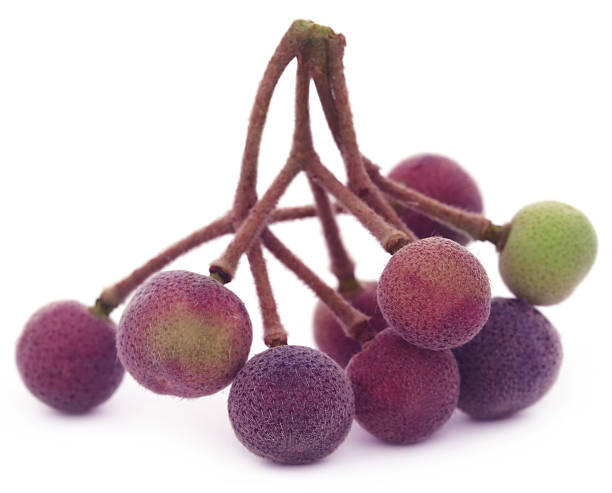Grewia Asiatica, Falsa, or Phalsa has its roots in South Asia and is closely related to the blueberry. While the summer may bring sweltering heat, it also brings some delicious fresh fruits – and we have to say that falsa are among our favorites.
Its popularity peaks in summer when restaurants and bakeries offer tangy-sweet desserts and juices based on the fruit. Juice them, sprinkle them on your salad, or eat them raw, this seasonal fruit can be enjoyed in so many ways.
The best thing about Falsas is that they are actually a very healthy snack. Besides being refreshing in the summer and calming down after a heatstroke, it contains many other health benefits as well.

health benefits of the fruit
There are a lot of minerals in it, such as magnesium, iron, calcium, and potassium, as well as vitamins A, B1, B2, B3, and C.
01) good for digestion
Juice of the false fruit acts as a digestive…with added benefits! According to the Encyclopedia of World Medicinal Plants, it not only regulates digestion but also serves as a great coolant and restores hydration to the body during stomach flu symptoms.
Botanical experts say Falsas juice can treat stomach pain (but you should consult a doctor to avoid allergic reactions or similar,
02) good for diabetes
As per an article published by the Pakistan Journal of Pharmaceutical Sciences, Falsas have a low glycemic index, so it can be consumed by both diabetics and those with cardiovascular diseases
03) Effectively Treats Anemia
Falsa contains massive amounts of iron, a mineral essential to monitoring synthesis and ensuring the smooth movement of blood between organs and tissues in the body. Consuming ripe fruit helps boost iron levels and fight fatigue and dizziness in people suffering from iron deficiency or anemia.
04) Provides joint pain relief
The antioxidant content of phalsa makes the unripened fruit anti-inflammatory. In conditions of arthritis and osteoporosis, this is extremely helpful in alleviating severe pain in the bones and also helps to increase joint mobility.
05) It produces a natural cooling effect
Infused with high water content, this luscious summer fruit is a perfect choice for cooling the body on a hot day, as well as during illness. To relieve the sweltering heat, squeeze the juice of phalsa, add a bit of jaggery and consume this desi sherbet.
06) Effectively Manages Malaria
Mosquito bites transmit malaria, a disease that affects both children and adults, particularly in the damp monsoon season. Adding a small serving of phalsa fruits to the regular diet confers valuable antipyretic or temperature/body heat-reducing, analgesic-pain-relieving qualities and greatly alleviates symptoms of body pain, fever, and discomfort often associated with malarial infections.
Side Effects Of Phalsa
- It is important to remember not to consume too much phalsa while pregnant or lactating, as it could cause extreme fluctuations in the body’s temperature.
- Phalsa fruits are best bought fresh from stores, as they retain their flavor and dewiness only for a few days after harvest.
plantation process of Falsa
Falsa fruit, additionally known as Grewia asiatica or Phalsa, is a tropical fruit that may be grown in certain climates. Here’s a popular guide on a way to grow Falsa fruit:
Climate and Soil Conditions:
Falsa grows nicely in tropical and subtropical climates.
The plant prefers well-draining soil with a barely acidic to neutral pH.
Planting:
Obtain Falsa seeds from a reputable supply or use seeds from ripe Falsa culmination.
Plant the seeds in a nursery or without delay inside the ground at an intensity of about 1-2 centimeters.
Watering:
Falsa vegetation requires everyday watering, in particular, all through dry spells or in the absence of rainfall.
Avoid waterlogged conditions as it may result in root rot.
Sunlight:
Falsa plants thrive in full sunlight. Ensure they obtain a minimum of 6-8 hours of direct daylight daily.
Fertilization:
Apply a balanced fertilizer, ideally one with a higher phosphorus content material for flowering and fruiting plants.
Organic fertilizers, such as properly rotted manure or compost, also can be beneficial.
Pruning:
Prune Falsa plants to eliminate useless or diseased branches and sell a nicely-formed canopy.
Pruning can also decorate air circulation and sunlight penetration.
Mulching:
Apply a layer of organic mulch across the base of the plant to preserve soil moisture, suppress weeds, and modify temperature.
Protection from Pests and Diseases:
Keep a watch on the flora for symptoms of pests or sicknesses.
Use suitable insecticides or herbal treatments to manipulate pests and save your sicknesses.
Support for Young Plants:
Provide a guide for young Falsa flora, specially all through windy conditions or whilst the plant is bearing fruit.
Harvesting:
Falsa end results generally ripen in overdue spring to early summer time.
Harvest the end result whilst they may be absolutely ripe, which is indicated via their dark red shade and sweet taste.
Post-Harvest Handling:
Handle Falsa fruits cautiously to keep away from bruising.
They are usually consumed clean, but can also be used in juices, jams, or desserts.
Remember that specific developing situations may vary depending on your region and local climate. It’s advisable to search for guidance from neighborhood agricultural extension offerings or horticulturists who can offer location-specific recommendations for correctly developing Falsa fruit for your place.
history of falsa
According to Wikipedia Falsa is a flowering plant that belongs to the mallow family Malvaceae. The plant was originally found in Varanasi, India, and was taken by Buddhist scholars to other Asian countries and the rest of the world. Grewia Celtidifolia was initially considered a variety of Falsa but is now considered a distinct species.
